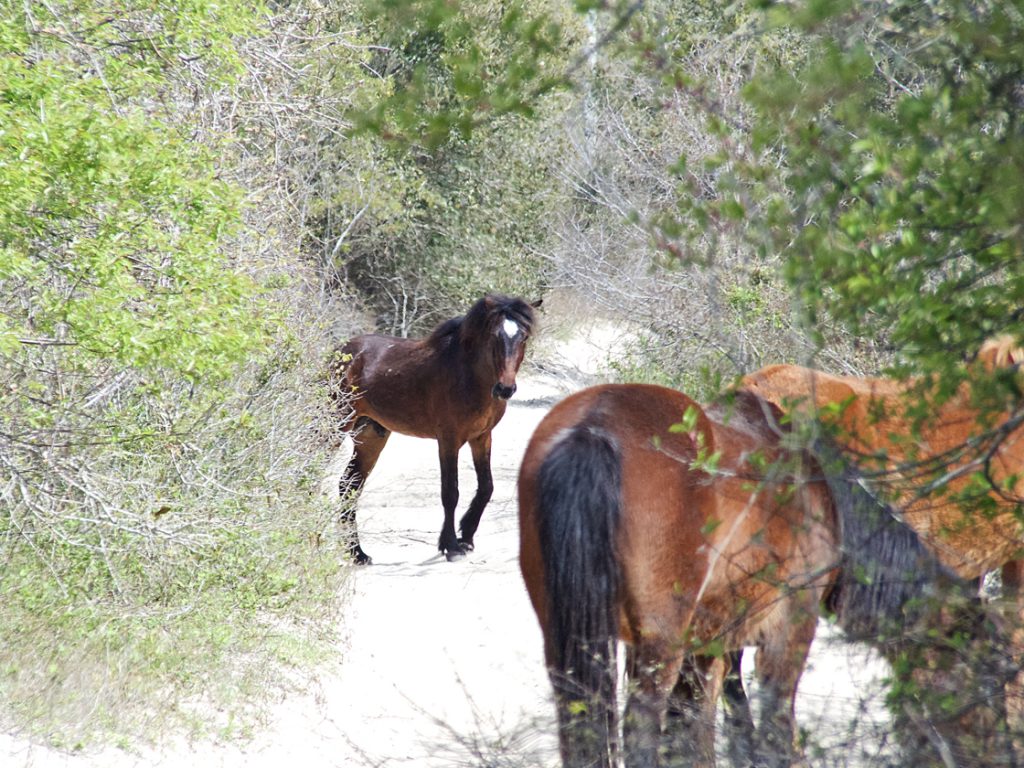
The Corolla Wild Horses have gotten themselves in the news again. It seems the herd has figured out that the fence meant to keep them in the 4WD area of the Currituck Banks is damaged. The fence runs from the Currituck Sound to the Atlantic Ocean.
Reports seem to indicate the horses like the lush green lawn of the Whalehead Club, although they've been seen grazing in a couple of areas. The folks from the Corolla Wild Horse fund have been doing a remarkably effective job of rounding up the escapees and getting them back north of the fence.
The damage is on the ocean side. There are plans to fix the fence, but the contractor is waiting for a west wind to make the surf a little more manageable.
It's a fun thing to think about in the winter of the year—the horses running free...people trying to round them up.
But there is a serious side to it.
Between 1985 and 1996, twenty horses were killed by cars. That's when that first attempt to build a fence—in 1996—and round up the herd up and move it north happened. There were a lot a lot of problems with that fence and it was rebuilt in 2004 and has been fairly effective.
There's a good reason to preserve the Corolla Wild horses. Along with the Shackleford Banks herd, they are the last remaining true Spanish Mustangs in the world. The mustangs of the American west, that are often thought of as the classic example of the breed, have crossbred with other horses so much that they are not considered a genetic example of mustangs.
Genetic testing has established that the Corolla herd are direct descendents of the horse of the Spanish Conquistadores.
A visual study of the horse also confirms that they are unlike any other breed of horse and have the physical characteristics history has said the horses had.
They are somewhat short and stocky with narrow but deep chests. They have shorter backs compared to their body than other breeds. They are a small breed of horse—700-900 pounds. The smaller ones are barely bigger than a pony.
They are also known to be very intelligent and very determined.
A Lot of Theories But Nothing Confirmed
How they got here is a bit of a mystery.
A shipwreck, perhaps. A wonderful thought—the horse escapes sure death and swims to its safety. It is, however, very unlikely.
At the time, the thought was that a horse's legs could not handle the movement of a ship at sea, so they were suspended below decks in a harness. To survive a shipwreck at sea, someone would have had release them from their harness, which seems improbable if the entire crew was on deck fighting to save the ship.
It's more likely that the Spanish explorers left their mounts behind for one reason or another. We know that the Spanish were very active in exploring the Eastern Seaboard of the United States. That is one of the reasons why Queen Elizabeth I granted Raleigh a royal charter to form a colony—as a counter to Spanish efforts.
There were also a number of unsuccessful attempts by the Spanish to establish colonies in the Southeast. When the Spanish left, it is very doubtful that they would have taken their livestock, including the horses, with them.
An interesting theory on that is somewhat plausible is the mustangs came with the ships of the doomed Lost Colony.
Spain and England were at war or on the verge of war in 1585 when Sir Walter Raleigh outfitted his second expedition to Roanoke Island.
Led by Sir Richard Grenville, the expedition stopped in the West Indies to buy livestock, including stallions and mares.
Approaching Roanoke Inlet from the south, the flotilla's flagship Tiger, ran aground, probably around Ocracoke Inlet although Diamond Shoals off Buxton is a possibility. Because it was the largest ship, it was carrying most of the supplies for the colony including the recently purchased livestock. Attempting to refloat the ship much of the supplies, including the livestock was thrown overboard.
If the livestock were survived, over time they could easily have migrated to the north. At the time that the Tiger ran aground, neither Hatteras Inlet nor Oregon Inlet existed. Those did not open until an 1846 hurricane. Although inlets opened periodically for the most part the Outer Banks was a continuous strand of sand from Ocracoke to Roanoke Inlet, directly across from Roanoke until about 1820 when Roanoke Inlet closed permanently.
That explanation does leave a lot unexplained. As an example, the Banker Horses as they became know, were common throughout coastal North Carolina from the Core Banks to the south to the Currituck Banks and Virginia by the 1700s.
Ocracoke Inlet, separating Ocracoke from Portsmouth Island, has been a wide, navigable inlet for as long as European explorers first marked it in the 16th century. Horses are good swimmers, but it would still have been a difficult crossing.
At one time there were a few thousand Banker horses roaming the Outer Banks. The story of what became of them is somewhat sad and involved and we'll save that for another day.
But remember, when a stallion and his harem (that's what it's called) are lazing on the Carova beach in the summer, what you are seeing is a living piece of the history of the United States.
And please, do not feed them and keep at least 50' away.
There is so much to learn about the Outer Banks. Spend a fascinating week or two in a Joe Lamb Jr. & Associates home and discover a place like no other.







